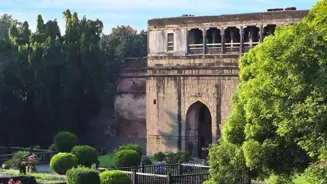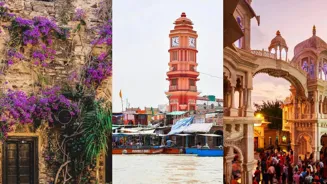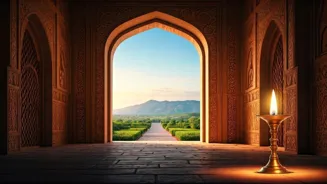Unveil India's Enchanting Mughal Gardens: A Journey Through History! Dive into the beauty and history of 5 stunning gardens!
India, a land known for its vibrant culture and rich history, boasts a treasure
trove of architectural marvels. Among these, the Mughal gardens stand out as serene oases of beauty and tranquility, reflecting the artistic sensibilities of the Mughal emperors.
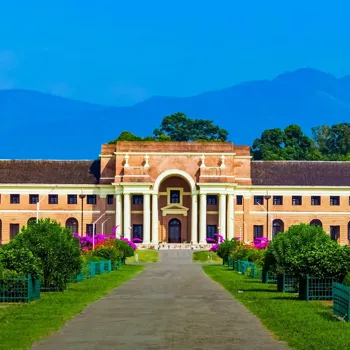
These gardens, with their intricate designs, flowing water channels, and fragrant blossoms, offer a glimpse into the luxurious lifestyle and refined aesthetics of the Mughal era.
Embark on a journey to discover five of the most enchanting Mughal gardens in India, each with its own unique charm and historical significance.
Shalimar Bagh in Srinagar: Mughal garden's beauty and history
Nestled on the banks of the Dal Lake in Srinagar, Jammu and Kashmir, Shalimar Bagh is a testament to Emperor Jahangir's love for his wife, Nur Jahan.
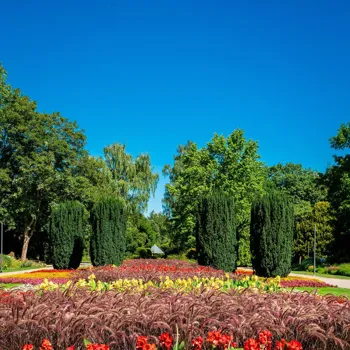
Built in 1619, this garden is a masterpiece of Mughal landscaping, featuring a series of terraces adorned with vibrant flowerbeds, towering Chinar trees, and cascading fountains.
The garden is divided into three sections, each with a distinct purpose: the outer garden for public access, the Emperor's garden, and the Empress's garden, reserved for the royal ladies.
The intricate water channels, known as "Shah Nahar," carry crystal-clear water throughout the garden, creating a soothing ambiance. Explore the pavilions and enjoy the spectacular views of the surrounding mountains.
Walking through Shalimar Bagh is like stepping back in time, experiencing the romance and grandeur of the Mughal era. The play of light and shadow, the fragrance of the flowers, and the sound of flowing water create a sensory experience that is both captivating and calming.
Nishat Bagh: Mughal garden with twelve terraces in Srinagar
Also located on the banks of the Dal Lake in Srinagar, Nishat Bagh, meaning "Garden of Bliss," is another stunning example of Mughal garden design. Built in 1633 by Asif Khan, Nur Jahan's brother, this garden is known for its twelve terraces, representing the twelve zodiac signs.
Each terrace is adorned with different flowers and plants, creating a kaleidoscope of colors. The garden offers breathtaking views of the Dal Lake and the surrounding Zabarwan mountains.
Take a leisurely stroll through the terraces, admiring the intricate details of the stonework and the vibrant beauty of the flora. Nishat Bagh is a perfect place to escape the hustle and bustle of city life and reconnect with nature.
The peaceful atmosphere and stunning scenery make it a popular destination for locals and tourists alike. The garden's design reflects the Mughal emperors' deep appreciation for nature and their ability to harmoniously blend architecture with the natural landscape.
Pinjore Garden: Unique Mughal-Rajput blend in Haryana foothills
Located in the foothills of the Shivalik range in Haryana, Pinjore Garden, also known as Yadavindra Garden, is a unique blend of Mughal and Rajput architectural styles. Built in the 17th century by Fidai Khan, a Mughal architect, the garden was later renovated by the rulers of the Patiala dynasty.
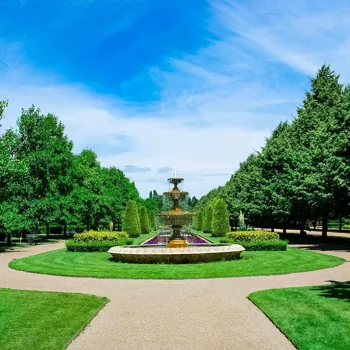
The garden features seven terraces, each with its own distinct design and character. Explore the Sheesh Mahal, a palace adorned with mirrors, the Rang Mahal, a painted palace, and the Japanese Garden, a more recent addition.
The garden also boasts a mini zoo, a nursery, and several picnic spots, making it an ideal destination for families. Pinjore Garden is a testament to the cultural exchange that occurred between the Mughals and the local Rajput rulers.
The garden's design reflects the blending of different artistic traditions, resulting in a unique and beautiful landscape. The garden provides a welcome respite from the heat of the plains and offers stunning views of the surrounding hills.
Humayun's Tomb: Iconic Mughal garden in Delhi
Located in Delhi, Humayun's Tomb is not only a magnificent mausoleum but also a stunning example of a Mughal garden. The tomb, built in the 16th century, is surrounded by a charbagh, a four-quartered garden, which is considered to be the first of its kind in the Indian subcontinent.
The garden is divided into four sections by walkways and water channels, creating a symmetrical and harmonious design. The garden is planted with a variety of trees and flowers, creating a peaceful and serene atmosphere.
The Humayun's Tomb garden served as a prototype for the gardens of the Taj Mahal, showcasing the evolution of Mughal garden design. The garden's importance lies not only in its aesthetic beauty but also in its historical significance as a precursor to one of the world's most famous landmarks.
Walking through the garden, one can appreciate the Mughal emperors' vision for creating beautiful and harmonious spaces.
Mughal gardens in Agra Fort offer glimpse into history and culture
Located within the Agra Fort, a UNESCO World Heritage Site, the gardens offer a glimpse into the lives of the Mughal emperors who once resided there. The fort itself is a massive structure, built over several generations, and the gardens provide a welcome contrast to the imposing architecture.
Originally, the fort contained numerous gardens, but many were destroyed or altered over time. However, some remnants of the Mughal gardens still exist, offering a glimpse into their original splendor.
Explore the Anguri Bagh, a grape garden, and the Mehtab Bagh, a garden located across the Yamuna River, which offers stunning views of the Taj Mahal. The gardens within the Agra Fort were witness to many historical events and played an important role in the lives of the Mughal emperors.
Walking through these gardens, one can imagine the emperors and their courtiers strolling through the pathways, discussing matters of state, and enjoying the beauty of nature. The gardens serve as a reminder of the rich history and cultural heritage of the Mughal empire.
